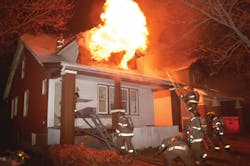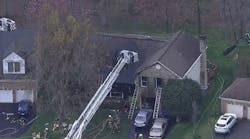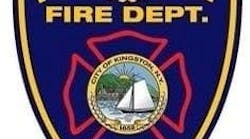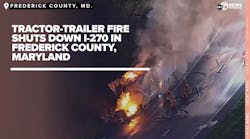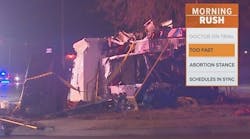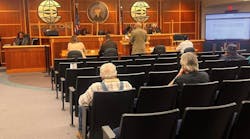A well-trained truck company can make the incident commander's job easier by identifying problems inside the fire building that might be unknown to command personnel. They are like combat engineers in the military who go in ahead of the main force and lead the way, removing obstacles for the commander and the force. This is called reconnaissance.
In a similar way, truck company members must report to the incident commander on each step they take to open up, search and ventilate. Members should search for hot spots and fire extension as they move through the building. Anything that seems out of order should be communicated to the incident commander. This is called company reconnaissance.
A truck company is also required to perform forcible entry as needed at the scene of an emergency. Whether it is through a door, window or other opening, it is the truck company's job to see that it is done. Entire firefighting operations have been stymied because there were no people to force entry. Something as simple as opening the right door at the right time can save a life or prevent the destruction of a building.
If you give your fellow firefighters a way in, it is always good practice to open a secondary way out. This is done in case you lose the original way in, for whatever reason. Let us look at the various entry points you may be called upon to breach:
Doors — There are four general types that must be considered. They are revolving, overhead, sliding and swinging. Each has its special characteristics and a fire department must practice with each.
Windows — The same holds true for windows. There are a number of different types, each with their own particular nuances — check rail, double hung, louver, jalousie and factory. Know them. And believe me when I say that practice in this area does make a difference.
Remember the simple statement found in the IFSTA Forcible Entry manual that tells us to always, "try before you pry." You do not necessarily have to break things. Be inventive and be non-invasive. However, if time is of the essence, "in is in," regardless of how you accomplish the task.
Ventilation
Ventilation operations are extremely critical elements of a truck company's bag of tricks. When performed correctly, ventilation can save lives, reduce the extension of fire and make the attack easier. In order to see that the job of ventilation at a fire is performed correctly, you should adhere to the following guidelines:
• Be sure that fire attack personnel are ready to deliver water
• Ventilate from the top down
• Ventilate from leeward to windward
• Crew of two to the roof position
• Officer and one or two firefighters to the interior
• Use existing openings on the roof as needed, such as doors, scuttles, skylights and vents, or create your own with a saw or use a pike pole to push the ceiling down
• Open the windows on leeward side first
I want you to vent high, vent low, vent often. One of the major problems encountered during firefighting operations involves smoke and heated fire gases. If not properly handled, they can be fatal. At the very least, they can slow an otherwise effective firefighting attack.
Vent high involves creating openings in the roof. This is not the simple task it once was. Newer lightweight truss construction has created roofs that will not stand up to the weight of a firefighter equipped with a full array of personal protective equipment (PPE). The best way to know what types of construction exist in your area is to visit and pre-plan buildings in your response area.
The manner in which one would vent an old three-story frame tenement in an urban area might be quite different from a modern townhouse or condominium. The same comparison could be made between a new lightweight steel warehouse and an old fire-resistive concrete monster. Many of these older buildings are simply too tough to fall down.
Because of the problem with modern construction, many fire departments have turned to positive-pressure ventilation (PPV). Here is our vent-low statement: Rather than creating openings in a structure to let the smoke out, high-pressure fans pump air into a fire building. This approach, though widely used, must be used carefully or it can spread the fire. You must be ready to move in quickly and take advantage of the effects of the PPV on the smoke and fire conditions. And you must have enough fans to do the job.
Vent often means to take any opportunity to let smoke out when you can. As you move through the building on your search pattern, pause and open windows wherever possible. If you are in a position to use roof ventilation, create one large opening (four by six feet minimum). This will have a better effect than a bunch of small holes and there will be fewer chances to fall through the roof if there are fewer holes.
Do not forget the old horizontal school of ventilation theory. Open windows on the leeward side first and then move to the windward side. This will allow a natural cross movement of air. You open the windows in the leeward/windward fashion so that there is not a sudden buildup of air. This may stimulate a backdraft if all other conditions are right.
Additional Tasks
When you think you are done, there is always one more thing to do. We have already addressed rescue, ventilation and laddering. Other tasks that you may need to consider are:
• Check for fire extension
• Salvage
• Overhaul
• Utility control
• Ladder pipe operations
• Property conservation as needed
Salvage has become the stepchild of the fire service. Many years ago, we took pride in this task. How many of you can remember being taught to leave the building in better shape than when you arrived? This is not necessarily the case any longer. Nonetheless, you should strive to preserve as much property as possible.
The primary problem comes from the fact that water is our weapon of choice. But effective salvage operations can reduce the damage toll. You can cover belongings, remove water from the building or remove endangered property to the exterior. Another aspect of salvage that is frequently overlooked involves removing water from the fire building to prevent structural damage.
The truck company is a critical component to leaving the building in a safe condition. They do this via the overhaul function. A truck company must overhaul in order to:
• Prevent rekindle
• Preserve any evidence of arson which you may find
• Do as little damage as possible
• Protect personal belongings
Ceilings, floors and walls must be opened up as needed. This will uncover the hidden fire that could spread unchecked if it is not found by the truck company. A number of very good stops have been made by firefighting crews that have opened up the fire building in order to cut off the fire. Many firefighters have been killed or injured because they were unaware of the presence of fire in a hidden area until it was too late. One of the primary objectives of a truck company is to "get it open."
Finding the fire can be a primary or secondary task for a truck company. You may well find some fire extension as an incidental sideline to search, rescue, ventilation and forcible entry, or it may be your primary task during overhaul. You should be aware of where the nearest hoseline is. You must be able to call for water whenever and wherever you need it. Prompt fire extinguishment can save a lot of time and property. A competent truck company can assist in this task.
Do not overlook building utilities during your fireground operations. A team of two firefighters should be ready to shut off gas, water and electric. This team should be equipped with a portable radio to maintain contact with command.
Fire personnel should be also trained to look for clues indicating a fire may have been intentionally set. Such things as multiple points of origin, excessive structural damage and familiar aromas should be noted and passed up the chain of command so that it can reach the proper investigative group. This training and experience will be particularly valuable during overhaul.
Property conservation is an operational area frequently overlooked by suppression personnel. You need to be sure that unnecessary damage is not done by operational personnel. Covering furniture and personal property with tarps and salvage covers can prevent water damage. De-watering operations include portable pumps, water vacuums, water slides and structural alterations that shunt water out of the building. People will remember that you took care not to do excessive damage to their property.
HARRY R. CARTER, Ph.D., a Firehouse® contributing editor, is a municipal fire protection consultant based in Adelphia, NJ, and a veteran of 47 years in the fire and emergency services. He is chairman of the Board of Commissioners in Howell Township Fire District 2 and retired from the Newark, NJ, Fire Department in 1999 as a battalion commander. Dr. Carter has also been a member of the Adelphia Fire Company since 1971, serving as chief in 1991. He is a life member and past president of the International Society of Fire Service Instructors and a life member of the National Fire Protection Association. Dr. Carter holds six degrees, with his terminal degree being a Ph.D. in organization and management, with a specialization in leadership, from Capella University in Minneapolis, MN, where he is an adjunct faculty member.
